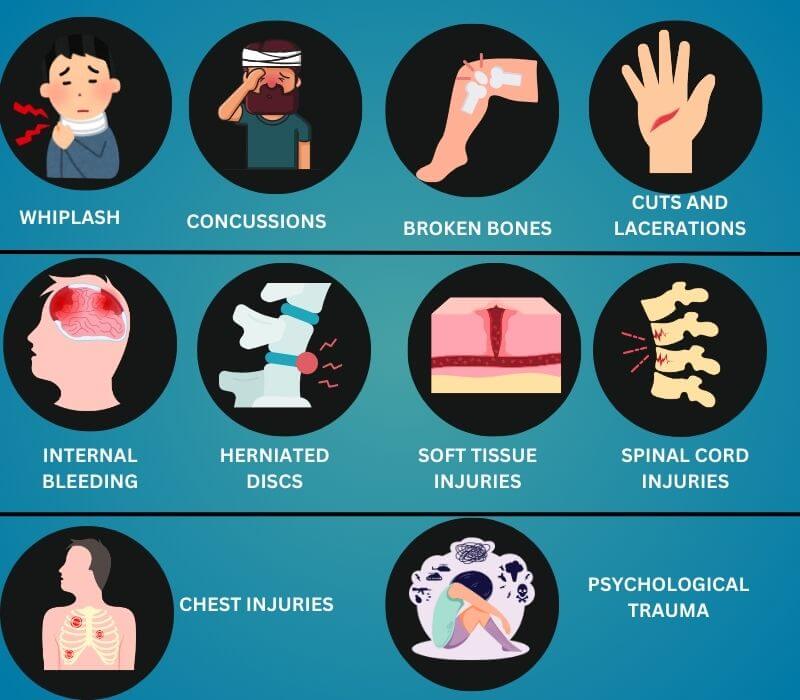Car accident injuries can range from minor bruises to severe, life-altering damage. Factors like your position in the vehicle, the type of collision, and whether you were wearing a seat belt all influence the extent of your injuries. Even what seems like a minor accident can lead to serious injuries, so seeking medical attention right away is essential.
These injuries can have lasting effects, sometimes impacting victims for years. Getting prompt medical care is critical not only to prevent further health issues but also to potentially save lives.
In this blog post, we’ll dive into everything you need to know about car accident injuries, including the different types, how they are diagnosed, and the treatments available. Understanding these can make a big difference in your recovery journey.
Top 10 Most Common Types of Car Accident Injuries

1. WHIPLASH
Whiplash is one of the most common injuries from car accidents. It occurs when the head is rapidly jerked forward and then backward, similar to the motion of a whip. This sudden movement can damage the ligaments, tendons, facet joints, discs, and muscles in the neck.
Symptoms:
- Neck pain and/or stiffness: This is the most common symptom and can range from mild discomfort to severe pain. It may be constant or worsen with movement.
- Intensifying neck pain with movement: Pain may become sharper when turning the head, looking up, or down.
- Limited range of motion in the neck: Difficulty in moving the neck or head due to pain and stiffness.
- Headaches: Often starting at the base of the skull and radiating towards the forehead.
- Dizziness and/or fatigue: A general feeling of being unwell, often accompanied by tiredness.
Risk Factors – Whiplash is more likely to be sustained in a traffic collision when:
- Rear-end collisions occur.
- Crashes involve vehicles traveling at higher speeds.
- Vehicle occupants’ heads are further away from headrests when the crash happens (leaving more room for the head to be snapped backward).
Potential Long-term Impacts:
- Chronic/persisting, waxing, and waning neck pain.
- Pain that radiates through the shoulders and/or arms.
- Severe headaches.
2. CONCUSSIONS
Concussions are a type of traumatic brain injury caused by a blow to the head or violent shaking of the head and body. They can result from direct impact or sudden deceleration.
Symptoms:
- Headache: Persistent headache that can vary in intensity.
- Confusion: Difficulty thinking clearly, feeling disoriented or confused.
- Dizziness: Sensation of spinning or losing balance.
- Nausea: Feeling sick to the stomach, sometimes accompanied by vomiting.
- Sensitivity to light or noise: Increased sensitivity to bright lights and loud sounds, can exacerbate headaches.
Risk Factors – Concussions are more likely to occur when:
- Head impacts occur during the collision.
- Seatbelts are not worn.
- High-speed collisions happen.
Potential Long-term Impacts:
- Memory problems.
- Difficulty concentrating.
- Mood changes.
- Persistent headaches.
3. BROKEN BONES
Fractures and breaks occur when bones cannot withstand the force of an impact. Car accidents often result in broken bones in the arms, legs, ribs, and pelvis.
Symptoms:
- Severe pain: Intense pain at the site of the fracture, which may increase with movement or pressure.
- Swelling: Inflammation and puffiness around the injured area.
- Bruising: Discoloration of the skin due to internal bleeding.
- Inability to move the affected area: Limited or no ability to move the part of the body where the bone is broken.
Risk Factors – Broken bones are more common in:
- High-speed collisions.
- Side-impact collisions.
- Accidents where airbags do not deploy.
Potential Long-term Impacts:
- Chronic pain.
- Arthritis.
- Limited mobility.
- Potential need for surgery.
4. CUTS AND LACERATIONS
These injuries result from sharp objects or shattered glass during the collision. Cuts and lacerations can range from minor to severe and may require stitches or even surgery.
Symptoms:
- Bleeding: External bleeding from the cut or laceration.
- Pain at the site of injury: Sharp or throbbing pain where the cut occurred.
- Visible wounds: Open wounds that can vary in depth and length.
Risk Factors – Cuts and lacerations are more likely to occur due to:
- Broken glass.
- Metal shards.
- Ejected objects within the car.
Potential Long-term Impacts:
- Scarring.
- Infection.
- Nerve damage.
5. INTERNAL BLEEDING
Internal bleeding occurs when blood vessels are damaged and bleed inside the body. This can be life-threatening if not treated promptly.
Symptoms:
- Abdominal pain: Sharp or aching pain in the abdomen, which may be localized or diffuse.
- Swelling: Enlargement of the abdomen due to internal blood accumulation.
- Dizziness: Feeling lightheaded or faint, which may indicate significant blood loss.
- Fainting: Loss of consciousness due to severe internal bleeding and blood pressure drop.
Risk Factors – Internal bleeding is more likely in:
- Severe impacts.
- Seatbelt misuse.
- High-speed collisions.
Potential Long-term Impacts:
- Organ damage.
- Prolonged recovery.
- Life-threatening complications if untreated.
6. HERNIATED DISCS
A herniated disc occurs when the discs between the vertebrae in the spine are displaced or ruptured, pressing on spinal nerves.
Symptoms:
- Back pain: Persistent or sharp pain in the lower back.
- Leg pain: Radiating pain down the leg (sciatica) caused by pressure on spinal nerves.
- Numbness: Loss of sensation in the lower back, legs, or feet.
- Tingling: A pins-and-needles sensation, particularly in the lower extremities.
Risk Factors – Herniated discs are more common in:
- Rear-end collisions.
- Heavy impacts.
- Individuals with pre-existing back issues.
Potential Long-term Impacts:
- Chronic back pain.
- Sciatica.
- Reduced mobility.
- Potential need for surgery.
7. SOFT TISSUE INJURIES
These injuries involve damage to muscles, ligaments, and tendons. They are often caused by the sudden jolts or impacts experienced in a collision.
Symptoms:
- Pain: Acute or chronic pain in the affected muscles, tendons, or ligaments.
- Swelling: Inflammation and puffiness around the injured area.
- Bruising: Discoloration due to internal bleeding within the soft tissues.
- Limited motion: Reduced ability to move the affected area due to pain and stiffness.
Risk Factors – Soft tissue injuries can occur in:
- All types of collisions.
- High-impact crashes.
- Situations where seatbelts are not worn.
Potential Long-term Impacts:
- Chronic pain.
- Joint instability.
- Reduced range of motion.
8. SPINAL CORD INJURIES
Damage to the spinal cord can result in a loss of function and sensation below the injury site. These injuries are among the most severe and can have lifelong consequences.
Symptoms:
- Loss of movement: Paralysis or weakness in the limbs below the injury site.
- Loss of sensation: Numbness or reduced ability to feel touch, heat, and cold below the injury site.
- Loss of function below the injury site: Impaired control over bowel and bladder functions.
Risk Factors – These injuries are more likely in:
- High-speed crashes.
- Rollover accidents.
- Situations where airbags do not deploy.
Potential Long-term Impacts:
- Paralysis.
- Chronic pain.
- Ongoing medical care.
- Rehabilitation.
9. CHEST INJURIES
Chest injuries often result from impact with the steering wheel, dashboard, or airbags. These can include broken ribs, collapsed lungs, or heart injuries.
Symptoms:
- Chest pain: Sharp or dull pain in the chest, which may worsen with breathing or movement.
- Difficulty breathing: Shortness of breath or inability to take deep breaths.
- Bruising: Discoloration of the skin around the chest area.
- Swelling: Puffiness and inflammation around the chest.
Risk Factors – These injuries are more common when:
- Seatbelts are misused.
- Airbags deploy forcefully.
- There is a direct impact on the steering wheel.
Potential Long-term Impacts:
- Rib fractures.
- Heart or lung injuries.
- Chronic pain.
10. PSYCHOLOGICAL TRAUMA
Accidents can also result in significant emotional and psychological distress, such as anxiety, depression, and post-traumatic stress disorder (PTSD).
Symptoms:
- Anxiety: Persistent worry, nervousness, or fear, especially when recalling the accident.
- Depression: Feelings of sadness, hopelessness, and a lack of interest in daily activities.
- PTSD: Flashbacks, nightmares, and severe anxiety related to the traumatic event.
- Sleep disturbances: Difficulty falling asleep or staying asleep, often due to stress or nightmares.
Risk Factors – Psychological trauma is more likely when:
- Accidents are severe.
- Individuals have prior mental health issues.
- There is a lack of support following the accident.
Potential Long-term Impacts:
- Ongoing mental health issues.
- Need for therapy.
- Impact on daily functioning and quality of life.
Understanding these common car accident injuries, their detailed symptoms, risk factors, and potential long-term impacts is crucial for recognizing the importance of immediate medical attention and appropriate treatment. This knowledge is essential for managing your health and recovery effectively.
In conclusion, understanding the Top 10 Car Accident Injuries is crucial for both prevention and effective treatment. By recognizing the signs and risks associated with these common injuries, individuals can take informed steps toward recovery and safeguard their health in the aftermath of a car accident.



